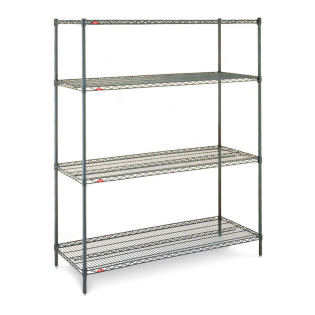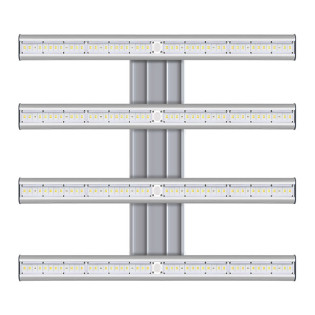
Vertical growing is the way of the future - at least some people think so. Others have no idea what it even is.
When you think about agriculture, what comes to mind? For most people, it’s growing crops in horizontal lines on the ground.
While this traditional system of agriculture has worked well for many years (centuries, even!) there’s a new method of growing food that’s taking the world by storm - vertical agriculture.
Vertical agriculture, or vertical growing, is the practice of growing plants by stacking or layering them, growing them vertically rather than horizontally.
Not only does it use less space, but vertical farming also can be done in a hydroponic setup. There are several methods, including indoor vertical farming.
But whatever the case may be, it’s a smart way to extend a growing season, extend a growing space, and extend your garden’s productivity. Here’s everything you need to know.
What Is Vertical Growing?
Vertical growing, or vertical agriculture is simply the idea of growing crops or any kind of plant in vertically stacked layers.
This method of farming often uses controlled systems like hydroponics, aeroponics, and aquaponics, but a vertical growing system could be as simple as a repurposed pallet leaning against the side of a house.
The idea first began to catch on in 1999, when it was proposed by a professor at Columbia University.
The main advantage of vertical agriculture is that you’ll produce a much higher crop yield than you would if you were growing in a horizontal fashion.
You can enjoy higher yields with less land, which is better for the environment and for growers in crowded urban areas.
What Can You Grow In A Vertical Farm?
Just about any kind of plant can be grown in a vertical farm. You’ll save space and your plants will receive much greater exposure to light and oxygen.
Of course, there are some plants that are better suited to this style of agriculture than others. Tomatoes, cherries, and peas are classic examples.
Tomatoes are easy to cultivate in this fashion, particularly when you choose a cultivar that can be trained to grow up a support system of trellis or stakes.
Peas also like to climb, making them an ideal candidate for a vertical garden. Some other options include:
- Cucumbers
- Summer squash
- Zucchini
- Hops
- Kiwi
- Passionfruit
- Okra
All of these foods like to climb, but produce moderately-sized fruits. This is important to consider - fruit/veggie weight. Heavier squash plants like melons and winter squash can sometimes prove to be too heavy for a vertical farm.
What Are The Pros & Cons Of Vertical Farming?

The advantages of this style of growing far outweigh the challenges in most cases. Not only can you cultivate a larger selection of crops all at once, since the crops won’t share the same plot of land, but you’ll also be able to use far less land.
This method of agriculture is ideal for growers in crowded urban or suburban areas. Furthermore, because vertical farming uses much less land, it is inherently less disruptive to local plants and wildlife.
Finally, vertical agriculture is advantageous to many growers because, in an indoor vertical farming system, in particular, everything is climate-controlled.
Crops are thus resistant to disruptions caused by the weather so that there is no risk of losing plants to extreme or unpredicted weather events.
What Are The Disadvantages Of Vertical Farming?
As with anything, though, there are some disadvantages of vertical farming. One is that setting up a vertical farm (in most cases) is much more expensive than starting a traditional farm.
When you start a traditional farm, typically all you need is a set of seeds and a place to grow (at the most basic level, of course).
Although there are some basic vertical farming systems out there, most are relatively complex and require significant financial expense in terms of installation and upkeep.
Some opponents also point to the fact that indoor vertical farming systems use more energy due to the use of supplementary light like LEDs, as a result contributing to pollution.
However, you also need to offest the pollution that is avoided with vertical farming - along with the smaller footprint these systems require. In this sense, they actually end up more efficient than traditional farms.
Also consider the fact that many systems can be really energy efficient - particularly those that use LED grow lights.
Can Vertical Farming Be The Future?

Despite the disadvantages of vertical farming, it is often hailed as the agricultural solution of the future.
It's efficient, particularly when compared to soil farming. This holds true even when you consider that many vertical agriculture producers require higher inputs of energy in the form of lighting and irrigation.
Beyond providing local communities with all the fresh produce they can eat, vertical agriculture could prove to be an opportunity to expand food production and expand agricultural operations to the rest of the world - even to growers in more urban areas.
Many companies and researchers have also begun to address the various challenges associated with vertical farming, too.
Some organizations are working to develop energy systems for vertical farms that rely on solar energy or use it as a supplement, making these systems even more efficient (and hopefully, in the future, more affordable as well).
Now, let's talk about how to get your vertical farm set up!
Equipment Needed To Start A Vertical Growing Operation

Ready to start your own vertical growing operation? It’s not necessarily an easy task, but with a bit of know-how and the right equipment, you’ll be able to do so in no time.
Before you get started, you need to think carefully about what kinds of plants you are trying to grow and what kind of set-up you are investing in.
While you can easily spend hundreds of thousands of dollars on a pricy hydroponic or aquaponics setup, at its most basic level, a vertical farm should have some kind of rack or shelving system.
This does not have to be complex. In fact, it could be as simple as a repurposed pallet, as mentioned earlier in this article.
Start With Some Vertical Racks

In general, you’ll want to invest in a set of high-quality racks that are made out of sturdy materials.
For a small operation, start with one 4 foot by 8 foot palletized rack. You can always add more later.
To make the most of your space, get a system that is stackable so you can take on more shelves later on.
Metro Shelving produces premium racking systems that can be used for vertical growing. Made from a variety of materials, you can choose one that is resistant to the wear and tear a growing environment creates.
Supplemental Lighting

You will also need a lighting system. LED lighting is absolutely essential for indoor vertical farms.
If you are growing in a greenhouse where some sunlight does get to your plants, you still need to consider supplemental lighting, as some intensity is certainly lost penetrating the greenhouse ceiling/walls.
And, in a racking system, plants on the lower levels will not be getting the light they need.
The wattage, spectrum, and size of your lights will be determined by what exactly you are trying to grow, so make sure you do some research on which kinds will be best for you.
Nutrients & Fertilizer
Nutrients are also essential, particularly if you are growing in a soilless setup.
The specific plants you are growing will require different plant nutrients. So do some research into what you want to grow.
But, you can start by reading our complete guide on nutrients & pH. It will help you understand the three primary nutrients all plants need - Nitrogen, Potassium, and Phosphorus.
You'll also learn about the importance of micronutrients, along with the relationship between nutrients and pH.
Other Garden Supplies
You’ll need other general gardening equipment that you would need in a traditional garden.
Some essential supplies include: a pH meter, soil test kit, sprayers, scissors, pruning shears, and seed starting trays, too.
We carry all these essential garden care supplies here at Hydrobuilder, at the best prices from the best brands. These are things you will need at some point or another, so just grab them and keep them on hand for when the time comes.
Automate Your Vertical Growing Operation
You can make your life a little easier by investing in some quality automation equipment.
Although this isn’t necessarily essential for novice growers, it’s something that should be viewed as a priority rather than a luxury.
Look for automation equipment that will enable you to set up automated feeding and watering systems, as well as those that can be used to regulate and control the lighting and atmosphere in your grow room.
The Sananbio Radix S-Vertical Growing Kit

Not sure where to start? The Sananbio Radix S-Vertical Growing Kit is a great option as you’re building your vertical farm.
This cutting-edge vertical growing technology is designed for the farmer at home, with everything you need besides plants and nutrients!
Its all-in-one design reduces the amount of research and purchasing you need to do to get started, too, as it has built-in LED fixtures and can be assembled in less than half an hour.
If you're looking to make the most out of your space at home or even commercially, vertical growing is the answer, and there is no easier way to start than with this system.
Final Thoughts On Vertical Growing
Vertical growing is the agriculture method of the future - and it doesn’t have to be daunting.
There are many benefits to starting a vertical farm, regardless of whether you are growing on a personal or commercial scale.
Consider the tips above as you begin your journey upward - rather than outward - into this exciting method of the future.
If you want to get your vertical growing operation started, head over to Hydrobuilder and grab the equipment and supplies you need!
If you aren't sure where to get started, you can reach out to our experts and we can help you design and set up your operation.





































